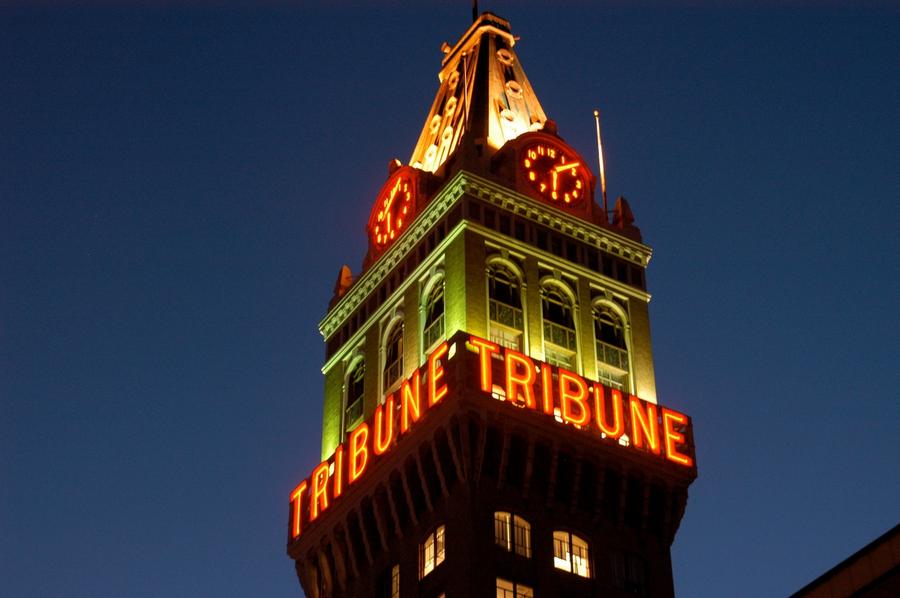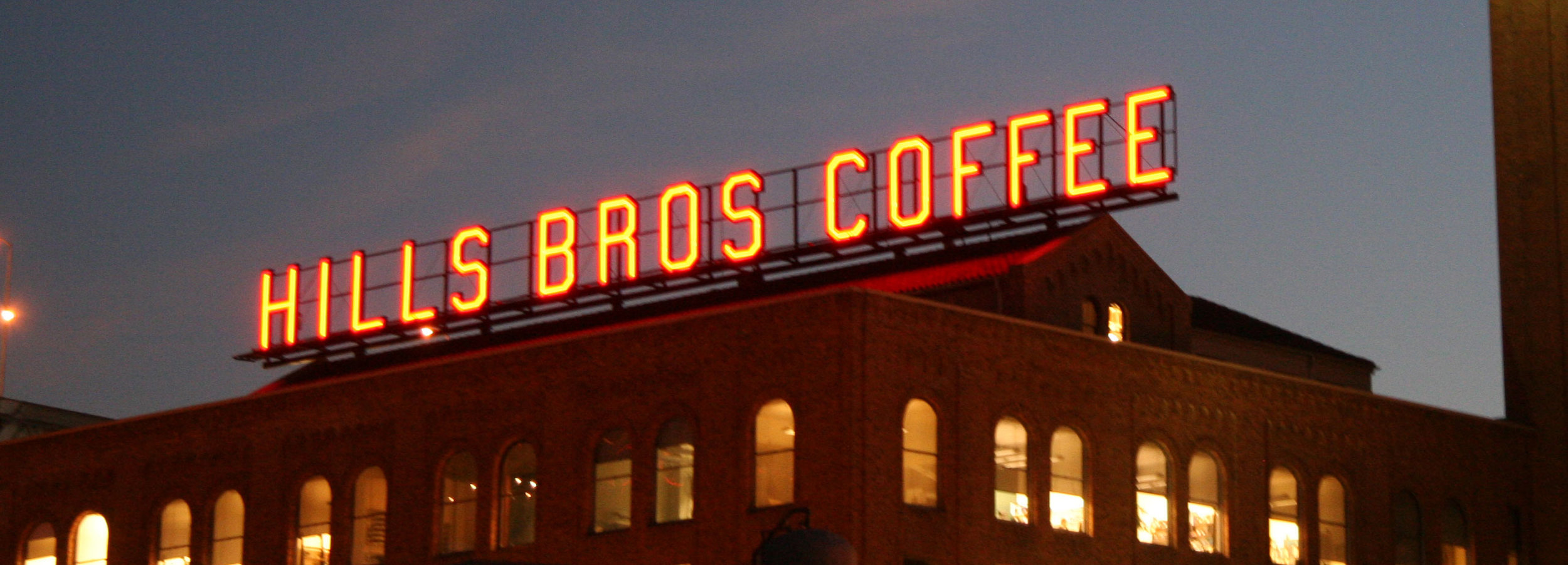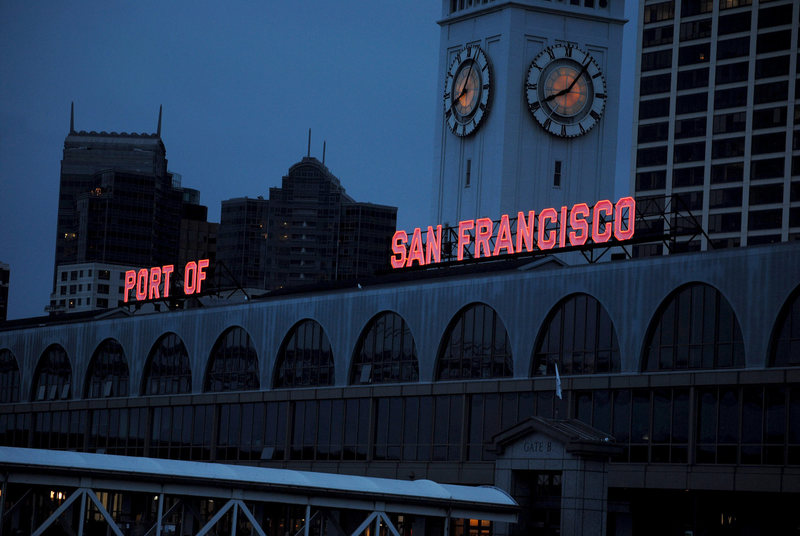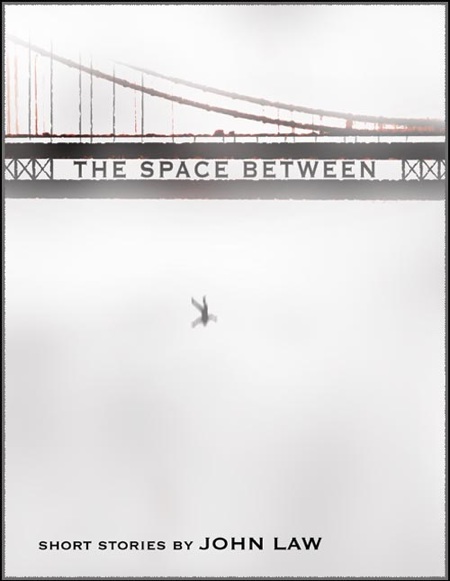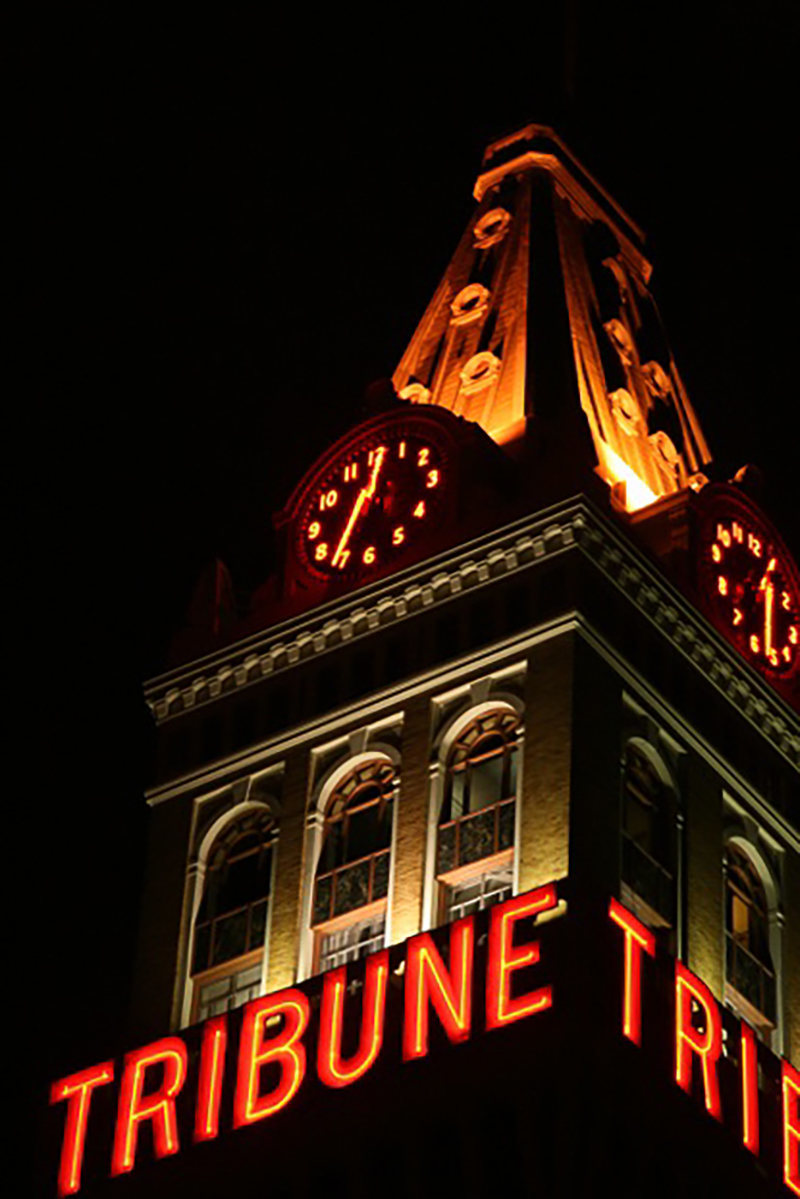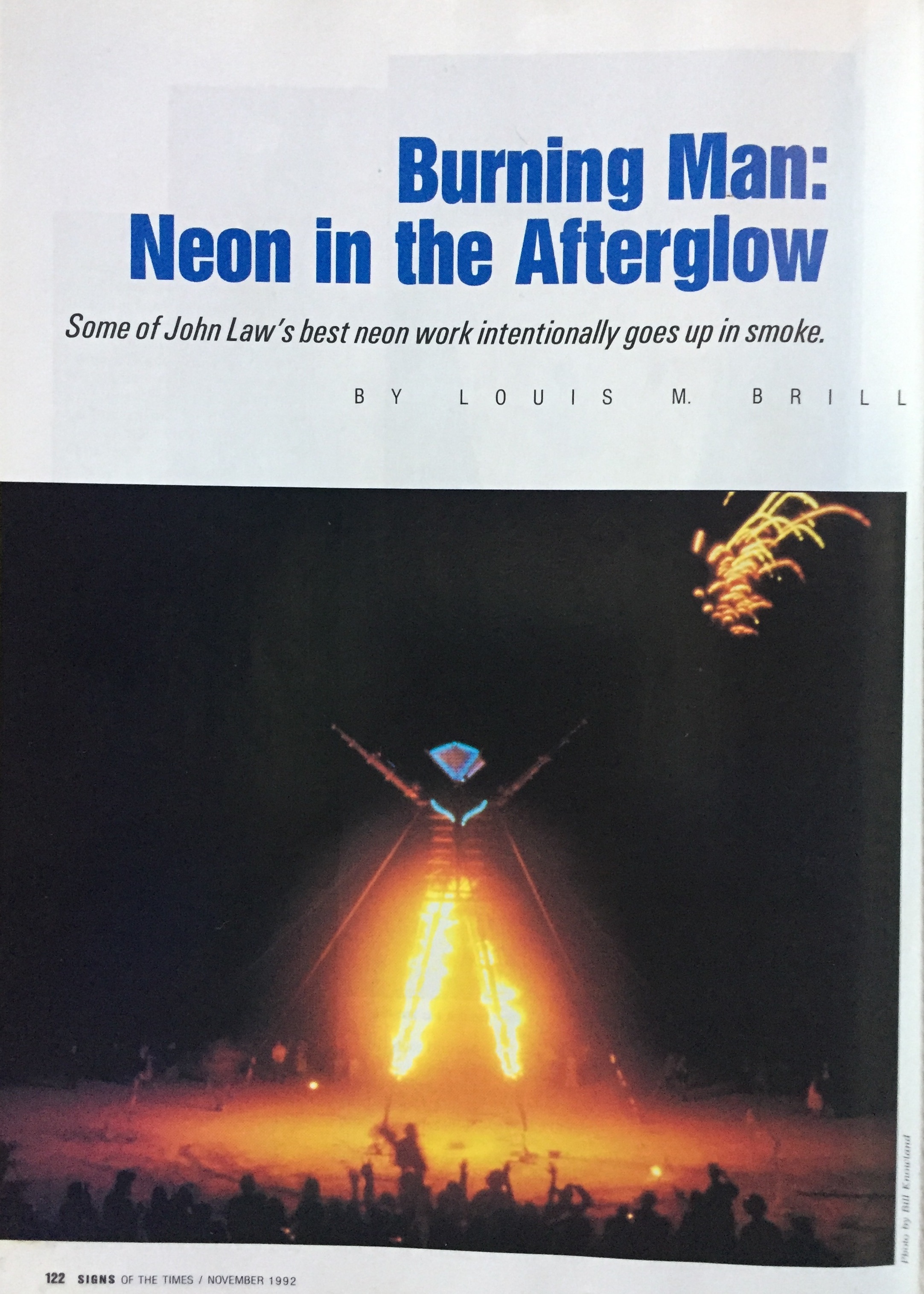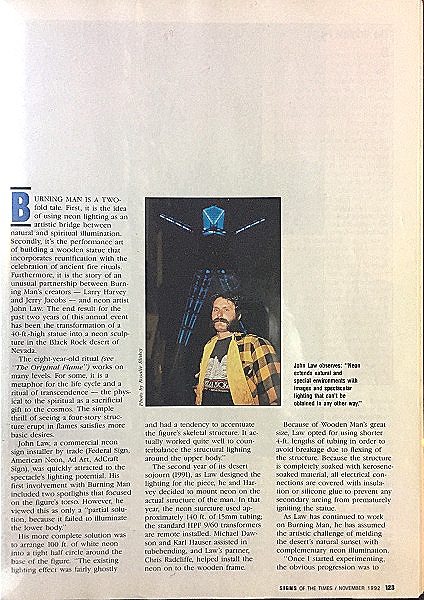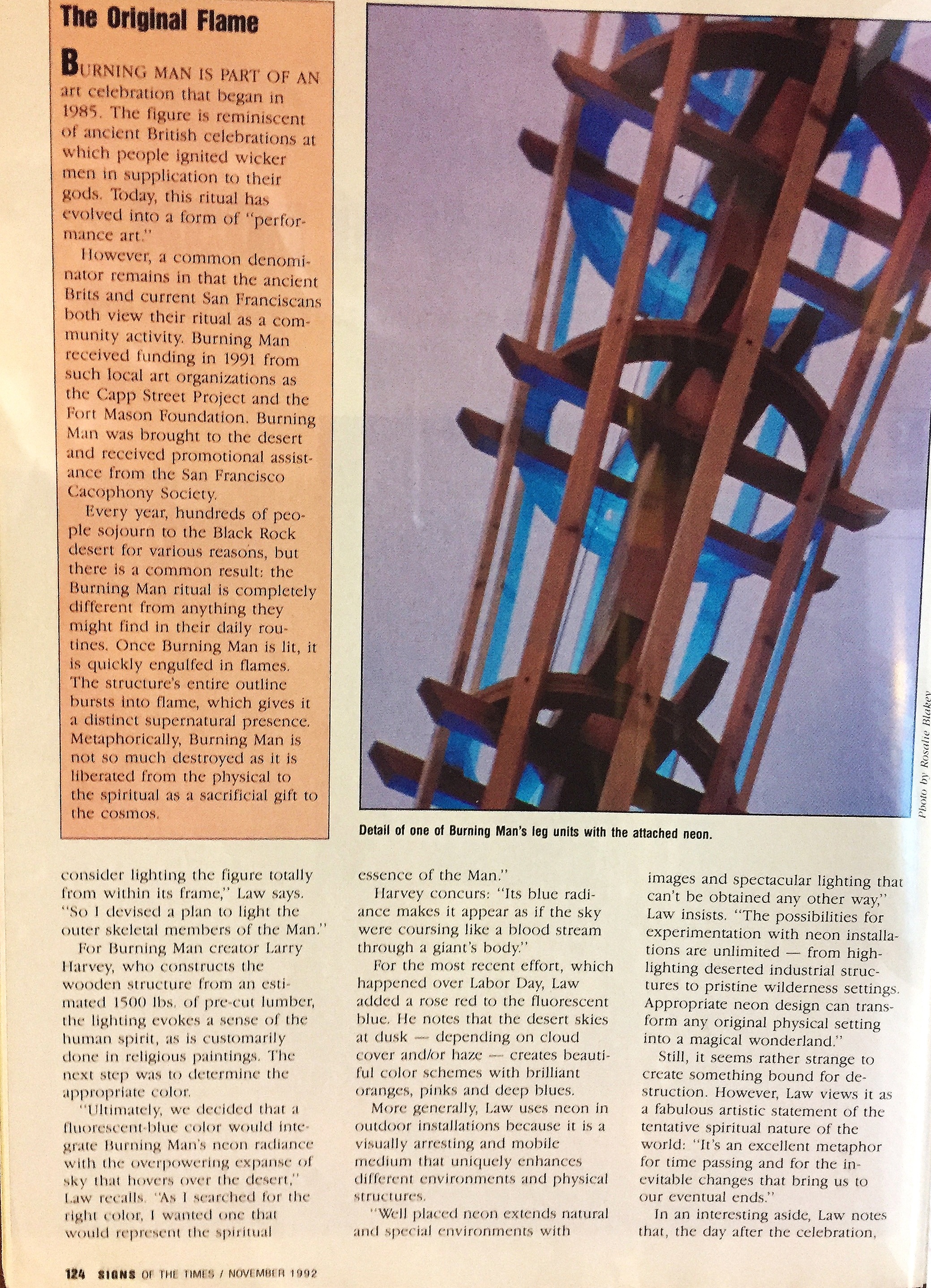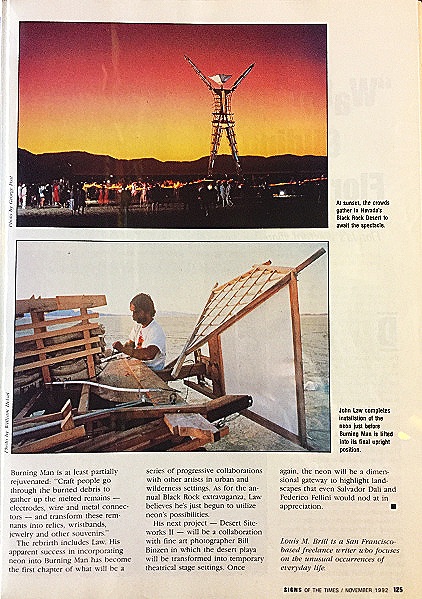John Law: Prankster, Neon Artist and Cacophonist and Co-Founder of Burning Man
John Law and Carrie Galbraith
John Law: Prankster, Neon Artist and Cacophony Society Principal, Co-Founder Burning Man
Early Life
John Law was born in San Luis Obispo, California, one of four children. At four or five, he moved to Oxford Mississippi for a year, where his father was a Professor at Ole Miss. That year Ole Miss admitted its first black student. John’s father, a vocal proponent of desegregation, was discharged from the University after getting in a scuffle with a student over desegregation. John’s family then moved to Big Rapids, in central Michigan, where his father found employment with the local college.
In 1967, when John was nine years old, his father took a summer class on computers in Santa Clara. While there, John’s family would climb in their station wagon to take the hour drive to San Francisco. These visits made an impression on John; he remembers the Golden Gate Bridge and the buffaloes in Golden Gate Park. But most of all, John remembers the family visiting Haight-Asbury to see the hippies living there. John recalls them being dirty, but looking like they were having a very good time. While his dad would make snide comments, John absorbed the scene with interest.
After the summer ended, the family returned to Michigan and then moved to Johnson City Tennessee in 1975, “a Gangster Town in the Middle of the Smokey Mountains”, with crime and racial tension. There the poor white kids hung out with the black kids, both of whom were shunned by the wealthy kids. While John, as the son of a college professor, was able to transcend class, he found himself drawn to the poor “wild kids”, and started to get into legal trouble, breaking into houses and stealing cars. John also was using drugs and alcohol from an early age, tripping on LSD at age 13. During this time his older sister was suffering from schizophrenia, and spent much of her life in and out of institutions until passing away in 2018.
While in Tennessee, Law graduated from high school a year early, and received a college scholarship to attend University of Tennessee, where he enrolled as a forestry major. During this time he also worked as an engraver at a jewelry store. After a few months, however, he ran into trouble with drugs and alcohol, and dropped out, ending up in a hospital for a few weeks. His dropout was precipitated by a mental health crisis.
A student in his dorm attempted suicide by jumping out of the building, and in the process John’s dorm room window was smashed. In a confused state, John began to believe he had been the one who jumped, eventually suspecting that he had actually succeeded in killing himself and was living in hell. Law also began to have hallucinations, and checked himself into a hospital. He lied about his condition, telling the staff that he had taken a large dose of LSD. Eventually Law found himself in a psych ward, where he had several violent episodes. (Read Ron Unger’s Vivid Account here)
John eventually was released and returned home, continuing to have hallucinations. At home, he reconnected with friends with whom he began to drink and take pills. This lead to a confrontation with his father, who punched him and knocked him unconscious. John decided to run away — he was 17 and on juvenile probation. He hitchhiked to Michigan to see his close friend Kenny Unger, and together they hitchhiked to Kenny’s brother Ron’s house, in San Francisco.
Upon moving to San Francisco he decided to give up all drugs and alcohol, and also gave up stealing and similar criminal activities. His mental state appeared to have settled, and he no longer suffered from issues he had encountered in Tennessee. (Law’s sister struggled with mental illness all her life, and by all accounts “lived a hard life” prior to her death).
John lived briefly in Golden Gate park in a sleeping bag, surviving by pan handling on Market Street and passing the time by playing chess and drinking coffee at Blue Unicorn and the Sacred Ground cafes. He then found a youth hostel, where he lived without paying rent by washing dishes and doing other cleanup work. He found better work at the Downtown Macy’s, working for a company that ran the watch and jewelry repair counter. With the money he was earning, he moved to a four bedroom apartment at Cole and Haight. The house became a “crash pad” for people they met, but were thrown out within four months. He finally moved into an apartment on Nob Hill with Kenny Unger’s brother Ron.
John, frustrated with people who express regret for not being able to experience the early days of the Suicide Club, Cacophony or Burning Man, frequently recounts the following observation: Living in San Francisco during the mid-seventies, he would meet aging hippies who would tell him “Oh, kid, you missed it. The party ended eight years ago.” And he would later reflect on this as utter nonsense. He was on the cusp of some of the greatest adventures of his life: Joining the Suicide Club, then the Cacophony Society, before helping to create Burning Man.
The Suicide Club
The Suicide Club
The Suicide Club was a secret society in San Francisco in early 1977. The club was founded by Gary Warne and three friends: Adrienne Burk, David Warren, and Nancy Prussia. Law first heard of the club when he read a description of it in the Communiversity calendar, which Ron Unger gave him. The Communiversity was part of the free school movement of the late sixties - free, student lead education, generally on any topic the student leaders wanted to sponsor, taught by volunteers. The Suicide Club description read, in part:
Have you ever explored a subterranean sewer at night with forty other people; climbed three stories on a swinging rope ladder to dine on the roof of a condemned building; staged practical jokes you’ve always fantasized about? No…? How about dinner at Rev. Moon’s or talking a policeman into hitting you with a pie? Well… we hadn’t either. The surviving members of the S.F. SUICIDE CLUB have agreed to EXPERIENCE THINGS THEY HAVEN’T EXPERIENCED BEFORE. In most cases they are challenges that we wouldn’t or couldn’t do alone because of the danger or need for team work. A large group also provides more investigators into the unknown, as uncovering mystery and adventure in the 20th Century requires a lot more detective work. Events generally fall into three categories: Adventures, infiltrations, and stunts. As you may notice in the above emphasized phrase, no WHY or PHILOSOPHY is attached…
The full description can be found here.
Ron Unger, John "Law’s roommate in the late 70s
Law’s friend Ron Unger had been encouraging Law to become involved in Communiversity, but before the Suicide Club, nothing had caught Law’s attention. However, Law was moved by the Suicide Club’s description:
I've never had a piece of writing speak more directly to me instantaneously and changed me. That was a tipping point. You know in everyone's life there's one or there one or two or three points where their entire life changes. Well this was a point for me. It was obvious from the second that I read [the club’s description] this is exactly what I want to do. My God! Who are these people they must be they must be amazing!
Law, at the urging of Unger, took the streetcar to Circus of the Soul bookstore, to meet the founders of the Suicide Club at Circus of the Soul used bookstore, which was owned by Gary Warne, the founder of the club. Law recalls expecting to meet people like Navy Seals, and has visions of black ops soldiers repelling into a conflict zone. Instead, he encountered Gary Warne, who look like a “slightly overweight hippie guy with long hair” and “then sitting next to him was like a really old guy … a super old guy in a big comfy chair. And he had a cane. And his leg was stuck out. He seemed like he was a hundred years old. . . turned out you he was 42 but see I was 17 so he might as well have been a 100”. The 42-year old was David T. Warren.
Despite the disappointing first impressions, Law attended the first initiation ceremony, which he has written about in detail here. The ceremony involved blindfolding the fifty or so participants, driving a circuitous route to the sea where the participants were led out of the car and told to hold hands. From there, still blindfolded, they were led along a dirt path, over a sandy bank and into a bunker. Blindfolds removed they then found their way back outside to an initiation party where they became members of the Suicide Club. Law had a profound experience and he devoted the next five years to the project, leading events including exploring abandoned buildings, exploring sewers and climbing bridges.
Around 1982 the club became inactive, and a year later, at age 35, Warne died of complications related to a blood disease. As requested in Warne’s will, Law and others Warne inspired climbed the Golden Gate bridge on a sunny day added some of Warne’s ashes to paint and applied it to the bridge. They then tossed more ashes to the wind.
The Cacophony Society
The Cacophony Society
Summer of 1986, Jean Moshofsky, Louise Jarmilowicz, Lance Alexander, Louis Brill, Sandy Hatch, Saffron Jeziorski, Joe Weinstein and John “Pepper” Dowdell held the first meeting of the Cacophony Society. Shortly thereafter Law became involved, and became a leader, hosting many of the most notable events. Many of the events Law hosted featured Urban Exploration (aka UrbEx), where he would lead groups through abandoned tunnels, buildings, ships and bunkers. During this period he also began to encounter members of Survival Research Labs (SRS), including its founder Mark Pauline.
Carrie Galbraith developed the idea of a "Zone Trip”, where Cacophony members would do a road trip to an alien environment. The first trip was to Los Angeles. The third trip (called Zone Trip #4), was created by Kevin Evans and Law and was a road trip to Black Rock Desert, and became the first Burning Man gathering in the desert. John was an integral participant in these events, and along with P Segal and Kevin Evans, convinced Larry Harvey to bring the Man to Black Rock.
During the Cacophony years, John and other Cacophists read Hakim Bey’s essay on the Temporary Autonomous Zone, which argued that society will always be controlled, so the only way to be free is to collectively agree to be temporarily free; gather your tribe, pick your place unknown to the state, gather and do what you want, and then run before the ruling class intervenes. When Law and others read TAZ they realized that Bey was writing theory about what the Cacophonists were already doing.
Burning Man
John Law and Larry Harvey had their first substantive interaction at the aborted 1990 Baker Beach burn. After the Larry negotiated with the police to allow him to raise but not burn the Man, John Law urged that the Man be burned anyway. As the semi-official police liaison for the SF Cacophony Club (if the police showed up, John would rush over to talk with them), he felt confident that the police were only “checking the box” by telling them not to do the burn, and wouldn’t return if the agreement was ignored. Harvey rejected this advice, later commenting that he had already given his word on the matter (and also commenting that others present didn’t have “skin in the game” about whether they could ever return to Baker Beach or whether there would be consequences for going ahead with the Burn).
As a result of the Man not being burned at Baker Beach in 1990, P Segal, Kevin Evans and Law convinced Larry Harvey and his then partner Jerry James to bring the man to Black Rock Desert to cap off the festivities of Zone Trip #4 - a Cacophony Society event planned for later in the year. Law, and other Cacophony members met at P Segal’s group home (1907 Golden Gate) to plan the event, and the first Burning Man in the desert was held in 1990, consisting almost exclusively of Cacophony members holding a Cacophony event.
John continued to work with Burning Man until 1996, and has not attended the event since that time. He parted company on poor terms; his last appearance at anything Burning Man related was a meeting in San Francisco after the 1996 event. During the same period, Flash Hopkins spread rumors that Law had stolen money, and by some accounts threatened Law, including threatening to burn down his house. As Law left the final meeting without speaking, Flash yelled accusations of financial improprieties, all of which are now widely discredited.
For his part, at the time Law was harshly critical of Larry Harvey. According to Brian Doherty in This is Burning Man, as of around 2003, Law was still “willing to call Larry evil and [to impute] the most uncharitable possible motives to his actions, backed up with the observation that he knows the man and worked with him for so long that he saw Larry’s true self. He claims that Larry’s charm and apparent good intentions are merely camouflage.”
John is quick to mention that while he played an important role in the foundation of Burning Man, he points to many others that played critical roles in the creating the event, including Vanessa Kuemmerle, Kevin Evans and others.
Desert Siteworks
In the early 90s, William Binzen began forming ideas for holding a week-long artist gathering near Black Rock Desert, where all attendees would be participants…there would be no spectators. While Binzen had a well-formed idea of what he wanted to achieve, he lacked the skill set to organize all the individuals needed to make his dream come to life. According to Law, Binzen wasn’t a “people person”, and learned of the Cacophony Society from his friend and Cacophonist Ed Homes (Bishop Joey). He began to participate in some events, he saw the organization as a tool to help make DSW come to life. In 1992, Binzen held the first Desert Sight Works. He then partnered with Law, along with Kevin Evans, Vanessa Kuemmerle, and Sebastian Hyde for the 1993 gathering (the following year Michael Mikel would also become involved). According to Law, Binzen came up with most of the core philosophy of Burning Man at DSW. Binzen and Harvey would hold regular lunches, where Binzen shared his idea for a participant driven art event.
Law did two installations at DSW, both neon. One underwater. Law found the Desert Site Works to be amazing events. 1994 featured dozens of pieces of installation art, and in that year Pepe Ozan also became involved in DSW; impressed, Law invited him to attend Burning Man.
Doggie Dinner Heads and Movie
John acquired three of the Doggie Dinner mascots. He, along with Flecher Fleudujon (whose mother was a Suicide Club member), also helped create a film, Head Trip, documenting a road trip from San Francisco to New York, with a “bus full of middle-aged performance artists” and three doggie heads in tow. Beyond the Doggie Heads, the film features the SF-based Cyclecide Bike Rodeo, stops at well-known “roadside attractions”. Visit the Doggie Head website. Media coverage here: SF Gate 2001.
Neon Work
In the early 80s, John worked as a permit and survey technician Ad-Art Sign Company. He then became a sign hanger/service for Federal Sign Company, Ad-Art and American Neon Sign Co. American Neon Sign Company was located n the Jingletown area of Oakland (a small art community). There Billy Greves taught John the art of neon. In 1988 John did work on the Oakland Clock building, under the mentorship of Billy and Steve Bagley. In 1996, John was hired to restore the Neon, which had been damaged during the Loma Prieta earthquake in 1989. He also negotiated for a small office on the top floor of the building, which he continues to maintain. In addition, he maintains the Port of San Francisco Sign on the Ferry Building and the Hills Brother Coffee Sign.
In 1990, at the first Burning Man at Black Rock Desert, John place a half circle of white neon at the base of the figure uplighting it and mounted two incandescent spots on the figures thighs pointing up to illuminate the torso and head. In 1991, the illumination became more complex, with John placing the neon inside the Man, which expanded in 1992 to cover the entire effigy. In 1996, as a prank, John installed a neon smiley face inside the Man, along with Chris Campbell (builder of the Man), which illuminated for three seconds at random intervals. Larry Harvey insisted that Dan Miller removed the neon. The smiley face was featured during John’s neon show.
Books
John has co-authored The Tales of the SF Cacophony Society. While the original and massive hardcover is now long out of print (and fetching $200+ on eBay), a 2nd Edition in softcover was released mid-2019. We also discuss Cacophony here.
In 2008, John released a book of fictional short stories about bridges entitled The Space Between, which features three fictional stories about San Francisco bridge, and one non-fiction story. One story, featured on the book’s cover, is about a character jumping from the bridge, based on a dream/nightmare John reports having several times. Other stories feature ghost elements, including the ghosts of people who jumped from the Golden Gate bridge returning. The book was dedicated to Gary Warne.
Current Projects
John currently maintains the neon at the Oakland Tribune building and works out of an office behind the clock face.
He recently released a 2nd Edition of the out of print Tales of the SF Cacophony Society.
John hosted a major neon exhibit at the Pro Arts Gallery. Read about it here.
John has also worked with Richard Marriott, who in 1992 led a car horn and light symphony at Burning Man, based on the Suicide Club. Steve Mobia assisted with the project.
John is a member of the Board for the SF Cultural History Museum, hosting a “collection of unexpected and off-the-wall San Francisco relics”, along with rotating exhibits from SF’s culturally important figures.
John lives in North Beach, San Francisco and is raising a son. He continues to be an active urban explorer, and has traveled the world exploring urban environments (2011 SF Gate Article). He remains a fan of literature and film, with an especial fondness for adventure and fantasy literature. He has several of his own writing projects ongoing.
Other Resources:
Catching the Next Wave (2019): John Law discusses his ProArts 2019 neon show here plus many of his other passions and projects.
Catching the Next Wave (2018): Listen here.
John discusses his history, including growing up and joining the SF Club and Cacophony Society. Part 1, Part 2
John discussed the Gorilla Grotto (and Sarah Davis’s first LSD trip) here.
More Information Coming Soon









